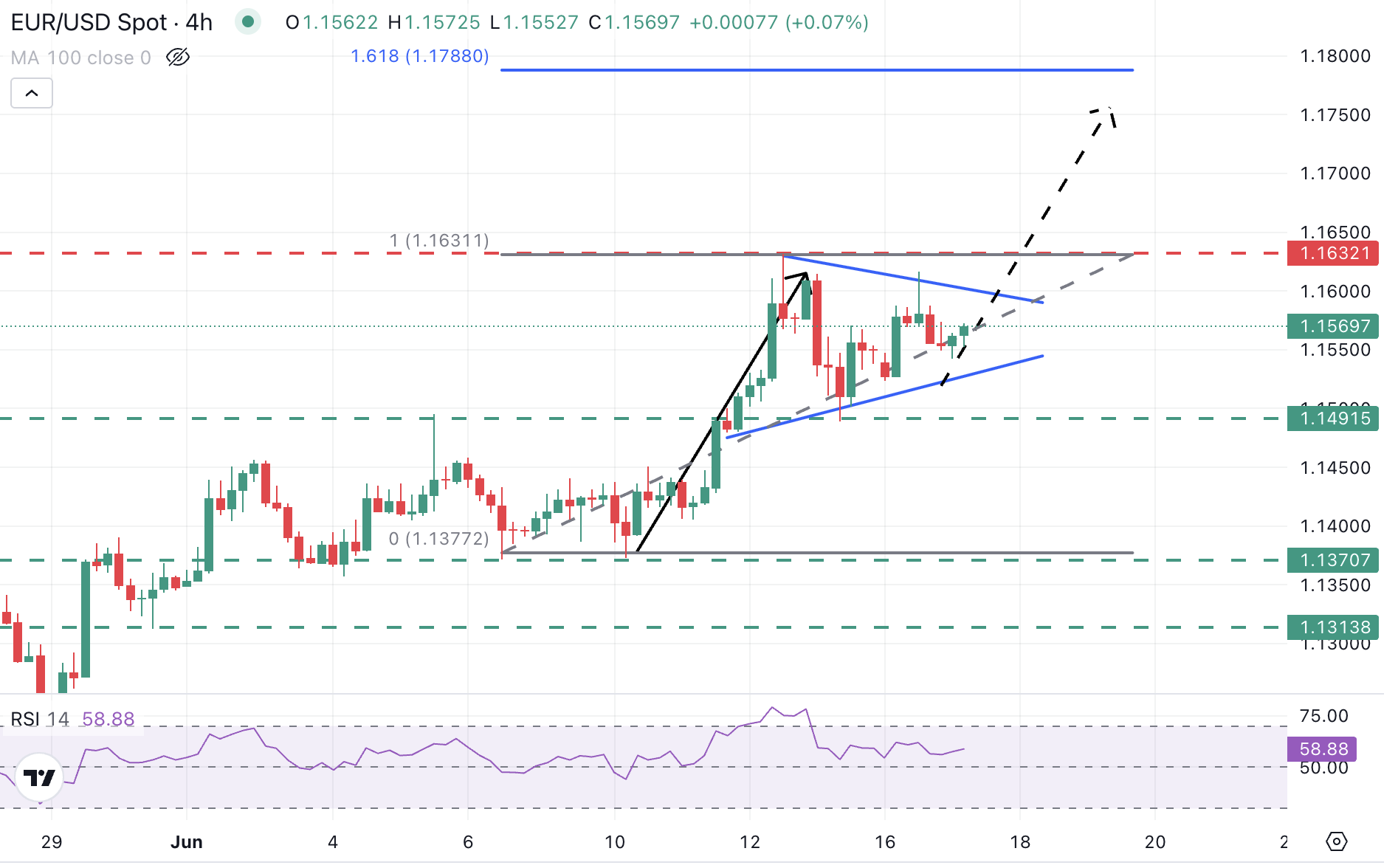EUR/USD hesitates within previous ranges as risk appetite fades
- The Euro trades practically flat on the day with risk appetite fading.
- Fears of escalation in the Middle East conflict are providing support to the US Dollar.
- EUR/USD is moving within a small triangle pattern around 1.1550.
The EUR/USD pair is trading practically flat, halfway through the 1.1500 range on Tuesday. Waning hopes of a truce in the Middle East have dampened risk appetite, but market volatility remains contained so far as investors await a slew of monetary policy decisions, including the Federal Reserve's (Fed) later this week.
Israel and Iran have continued exchanging fire for the fifth day, and US President Donald Trump has urged citizens to evacuate Tehran, before leaving the G7 summit one day earlier to meet with the National Security Council. Concerns that the US might get involved in the conflict have boosted risk aversion.
Nevertheless, market moves remain limited so far, with investors looking from the sidelines ahead of US Retail Sales data, due later on Tuesday, and the outcome of the Fed's monetary policy meeting, on Wednesday.
The US central bank is widely expected to leave rates unchanged, but investors will be particularly attentive to the summary of economic projections and potential variations in the dot plot to asses the path of interest rates in the near term.
Daily digest market movers: The US Dollar recovers its safe-haven status
- Trump's hasty exit from the G7 summit has boosted concerns that the US might get involved in the Israel-Iran conflict. The news has crushed investors' appetite for risk and provided some support to the US Dollar on higher demand for safe assets.
- Israel and Iran continued exchanging missiles before that. Iran vowed to launch its largest missile attack in history at Israel, while Israeli Prime Minister Benjamin Netanyahu threatened to kill Iran's Supreme Leader, Ali Khamenei. In the meantime, Trump's call to Tehran citizens to leave the city has fuelled concerns of a serious escalation of the conflict.
- The market reaction has been risk-averse, yet with limited volatility so far. Traders are in a wait-and-see mode, awaiting the Fed interest rate decision later in the week. The US Dollar Index (DXY), which measures the value of the USD against a basket of the most-traded currencies, is moving right above the 98.00 level, not far from last week's multi-year lows.
- In the macroeconomic front, the focus on Tuesday will be on the US Retail Sales data, which are expected to show a significant 0.7% contraction in May after a 0.1% growth in April, showing further evidence of the negative impact of the tariff turmoil in the US economy.
- In the European session, the ZEW Economic Sentiment Survey is expected to show a minor improvement in June, although the impact on the Euro is likely to be subdued, with geopolitical tensions front and center in the market.
- The highlight of the week will be the Federal Reserve's monetary policy decision on Wednesday. The bank will, most probably, leave its benchmark interest rate unchanged at the current 4.25%-4.5% range, but investors will be looking for changes in the interest rate projections, which pointed to two more rate cuts this year, and the growth and inflation forecasts.
- US data released on Monday revealed a sharp deterioration of the NY Fed Manufacturing Index, which fell to a reading of -16 in June, against expectations of a moderate improvement to -5.5 from -9.2 in May.
Technical analysis: EUR/USD forming a small triangle around 1.1550

EUR/USD has been moving within an ever-tightening range since peaking above 1.1600 last week, forming a small triangle. Technical studies say that this is a continuation pattern, suggesting a bullish outcome.
The top of the triangle, now around 1.1600, is likely to hold bulls ahead of the June 12 high at 1.1630. Above here, the 1.1700 psychological level might attract sellers. The triangle pattern's measured target is at 1.1750.
On the downside, the triangle bottom is at 1.1525 ahead of the June 13 low at around 1.1490. Below here, the bullish trend would be called into question, with pressure increasing towards 1.1370 (June 6 and 10 lows).
Risk sentiment FAQs
In the world of financial jargon the two widely used terms “risk-on” and “risk off'' refer to the level of risk that investors are willing to stomach during the period referenced. In a “risk-on” market, investors are optimistic about the future and more willing to buy risky assets. In a “risk-off” market investors start to ‘play it safe’ because they are worried about the future, and therefore buy less risky assets that are more certain of bringing a return, even if it is relatively modest.
Typically, during periods of “risk-on”, stock markets will rise, most commodities – except Gold – will also gain in value, since they benefit from a positive growth outlook. The currencies of nations that are heavy commodity exporters strengthen because of increased demand, and Cryptocurrencies rise. In a “risk-off” market, Bonds go up – especially major government Bonds – Gold shines, and safe-haven currencies such as the Japanese Yen, Swiss Franc and US Dollar all benefit.
The Australian Dollar (AUD), the Canadian Dollar (CAD), the New Zealand Dollar (NZD) and minor FX like the Ruble (RUB) and the South African Rand (ZAR), all tend to rise in markets that are “risk-on”. This is because the economies of these currencies are heavily reliant on commodity exports for growth, and commodities tend to rise in price during risk-on periods. This is because investors foresee greater demand for raw materials in the future due to heightened economic activity.
The major currencies that tend to rise during periods of “risk-off” are the US Dollar (USD), the Japanese Yen (JPY) and the Swiss Franc (CHF). The US Dollar, because it is the world’s reserve currency, and because in times of crisis investors buy US government debt, which is seen as safe because the largest economy in the world is unlikely to default. The Yen, from increased demand for Japanese government bonds, because a high proportion are held by domestic investors who are unlikely to dump them – even in a crisis. The Swiss Franc, because strict Swiss banking laws offer investors enhanced capital protection.

